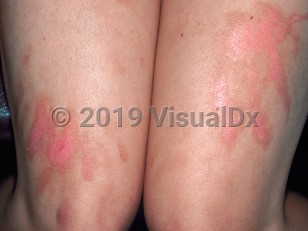Phytophotodermatitis in Adult
Alerts and Notices
Important News & Links
Synopsis

Phytophotodermatitis is a cutaneous phototoxic eruption caused by the interaction of furocoumarins found in some common plants with solar UVA radiation. It is a common skin complaint in travelers to tropical regions. Approximately 24 hours after plant contact with subsequent exposure to sunlight, a burning erythema develops. Limes, other citrus fruits, celery, figs, meadow grass, certain weeds, and oil of bergamot are frequently causative. Exposure to the plant sap of wild parsnip (Pastinaca sativa; "poison parsnip"), common throughout the United States, can cause severe phytophotodermatitis (when in bloom it looks similar to Queen Anne's lace or dill plant and grows to around 4 feet tall). Common scenarios include squeezing limes outdoors, gardening and agricultural work, and hiking or biking in areas of causative plants.
There is no predilection for any age or ethnicity or either sex, although phytophotodermatitis may be more noticeable in lighter skin phototypes. Bartenders and revelers handling citrus fruits are at higher risk. The condition is benign and self-limited, and treatment is supportive.
The term "Berloque dermatitis" refers to phytophotodermatitis from natural oil of bergamot in perfumes. This eruption is typically seen on the face and neck of women applying aerosolized fragrances. This has become rare since the introduction of artificial oil of bergamot.
Related topic: Hogweed dermatitis
There is no predilection for any age or ethnicity or either sex, although phytophotodermatitis may be more noticeable in lighter skin phototypes. Bartenders and revelers handling citrus fruits are at higher risk. The condition is benign and self-limited, and treatment is supportive.
The term "Berloque dermatitis" refers to phytophotodermatitis from natural oil of bergamot in perfumes. This eruption is typically seen on the face and neck of women applying aerosolized fragrances. This has become rare since the introduction of artificial oil of bergamot.
Related topic: Hogweed dermatitis
Codes
ICD10CM:
L56.2 – Photocontact dermatitis [berloque dermatitis]
SNOMEDCT:
238521005 – Phytophotodermatitis
L56.2 – Photocontact dermatitis [berloque dermatitis]
SNOMEDCT:
238521005 – Phytophotodermatitis
Look For
Subscription Required
Diagnostic Pearls
Subscription Required
Differential Diagnosis & Pitfalls

To perform a comparison, select diagnoses from the classic differential
Subscription Required
Best Tests
Subscription Required
Management Pearls
Subscription Required
Therapy
Subscription Required
References
Subscription Required
Last Updated:08/07/2017
 Patient Information for Phytophotodermatitis in Adult
Patient Information for Phytophotodermatitis in Adult
Premium Feature
VisualDx Patient Handouts
Available in the Elite package
- Improve treatment compliance
- Reduce after-hours questions
- Increase patient engagement and satisfaction
- Written in clear, easy-to-understand language. No confusing jargon.
- Available in English and Spanish
- Print out or email directly to your patient
Upgrade Today


